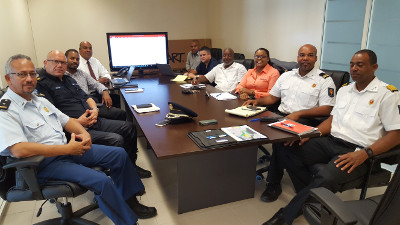 GREAT BAY (DCOMM):--- A small Work Group (WG) within the Emergency Support Functions (ESF) that falls under the Emergency Operations Center (EOC), has been formed to assess and ensure National Tsunami Preparedness within the Government apparatus, and to develop a national tsunami preparedness plan.
GREAT BAY (DCOMM):--- A small Work Group (WG) within the Emergency Support Functions (ESF) that falls under the Emergency Operations Center (EOC), has been formed to assess and ensure National Tsunami Preparedness within the Government apparatus, and to develop a national tsunami preparedness plan.
A tsunami is a very large ocean wave caused by an underwater earthquake or volcanic eruption.
On Tuesday a meeting chaired by the EOC Disaster Coordinator and Fire Chief Clive Richardson, and supported by ESF-10 Coordinator and Secretary General of the Ministry of Tourism, Economic Affairs, Transportation and Telecommunications (Ministry TEATT) Miguel de Weever, brought together various government agencies that are part of the WG.
The WG is a joint initiative of the Office of Disaster Management and Ministry TEATT.
The agencies are: Sint Maarten Police Department, Fire Department/Office of Disaster Management, Meteorological Department of St. Maarten, St. Maarten Tourist Bureau, Department of Communication (DCOMM), and the Ministry of Public Housing, Spatial Planning, Environment, and Infrastructure Management (Ministry VROMI).
The WG and subgroups will meet on a regular basis and will be working on a number of areas such as warning systems, designated safe areas, public awareness campaign and post-Tsunami event.
One of the key areas discussed is the identification of an alarm center(s) that would then activate the EOC. This is critical, as evident in the real-life event of Tuesday, January 9 in the middle of the night when an earthquake in the Western Caribbean Sea resulted in a tsunami warning being issued for parts of the Caribbean.
The WG will be looking at the various forms of warning systems to ensure that the country has a comprehensive and effective system such as a siren alarm system and/or using electronic messaging via Smart Phones to alert the population and what action is required. The system should also be able to issue messages in various languages.
The designation of Safe Areas where persons in the various low-lying districts need to go for safety are to be identified. The traffic flow via identified evacuation routes and the logistics need to be worked on in order to maximize the survival rate of the population.
A Public Awareness Campaign will be necessary to sensitize the population about the alarm system that would be put in place; what actions a person is required to take; the evacuation route etc. The Public Awareness Campaign would also cater to specific publics such as public, schools (i.e. Children), Tourists, Vulnerable Persons/groups, etc.
Besides being able to respond to a tsunami event, the WG will also look at a Post-Tsunami Sint Maarten and what will be required in the aftermath.
Members of the WG were of the opinion that Hurricane Irma has thought us many valuable lessons and one needs to ensure that we have an improved plan to execute and protect life, community and property on Sint Maarten during a natural disaster.
In the past 500 years, there have been ten confirmed earthquake-generated tsunamis in the Caribbean Basin with four causing fatalities. An estimated 350 people in the Caribbean were killed by these events.
During the relatively short 500-year period of written Caribbean history, tsunamis have inflicted a small amount of losses compared to other hazards such as windstorms, earthquakes, and volcanic activity. The impact of a large tsunami can be as devastating as earthquakes or an erupting volcano.
The Eastern Caribbean islands lie in a setting where major structural changes are occurring in the Earth’s crust. All known sources capable of causing tsunamis (that is, earthquakes, volcanic eruptions, landslides) occur within striking distance of the Eastern Caribbean, and there are also distant sources across the Atlantic.
Since the islands lie in an area of relatively high earthquake activity for the Caribbean, the most likely tsunamis to affect the Eastern Caribbean are those which can be triggered by shallow earthquakes (<50km depth), in the region, greater than magnitude 6.5, according to the Seismic Unit of the University of the West Indies.












